#cygnus loop
Photo

Cygnus Loop © Aleix Roig
#space#cygnus loop#astrophotography#universe#stars#nebula#night sky#solar system#astronomy#cosmos#galaxy#planet#nasa#planets
2K notes
·
View notes
Text

Rampaging Fronts of the Veil Nebula - March 7th, 1996.
"A supernova explosion of a high-mass star results in fast moving blast waves. At the front of the waves shown above, ionised gas in the Veil Supernova Remnant rushes out from the explosion, sweeps up material, and breaks up many atoms into constituent ions and electrons. Observations with the Hubble Space Telescope in 1993 indicate that the blue shock wave was catapulted away from the stellar explosion after the red shock wave, and had yet to catch up to it in some regions. The Veil supernova remnant's has a very large angular size - six times the diameter of the full Moon - and different parts of it are known as the "Cygnus Loop" and catalog numbers NGC 6960, NGC 6979, NGC 6992, and NGC 6995."
#nasa#space#cosmos#universe#astronomy#astrophysics#astrophotography#veil nebula#supernova remnant#cygnus loop
110 notes
·
View notes
Photo

Pickering’s Triangle, part of the Veil Nebula // Alexandre EGON
#astronomy#astrophotography#nebula#emission nebula#supernova remnant#pickering's triangle#veil nebula#cygnus loop#cygnus
253 notes
·
View notes
Text

Ic 1805 - The Heart Nebula
Photographer David Joyce - Space From My Backyard: Pictures I Took With A Telescope
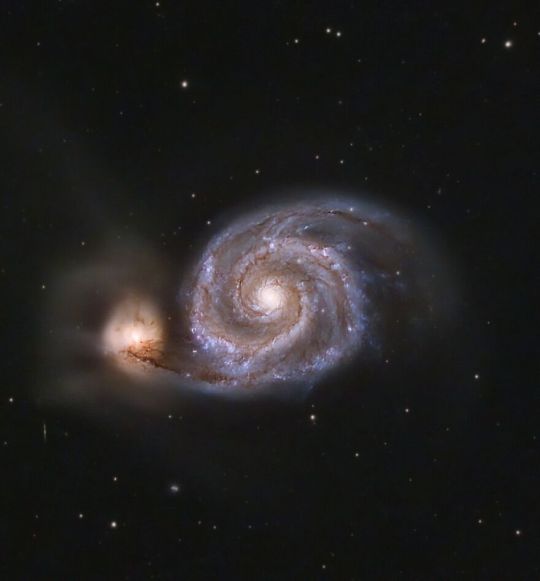
M51 - The Whirlpool Galaxy
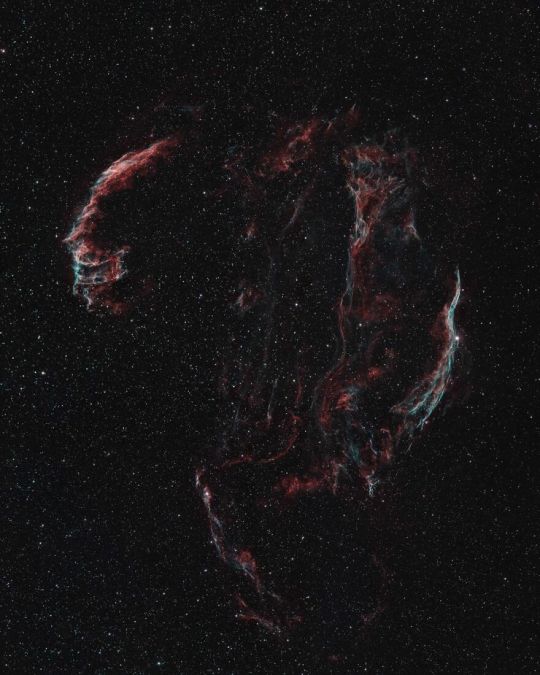
The Cygnus Loop - A 4

M81 - Bode’s Galaxy

Ngc2244 - The Skull Nebula/Rosette Nebula
#david joyce#photographer#astronomy#space#heart nebula#telescope#nebula#whirlpool galaxy#galaxy#cygnus loop#bode's galaxy#skull nebula#rosette nebula#nature
78 notes
·
View notes
Photo
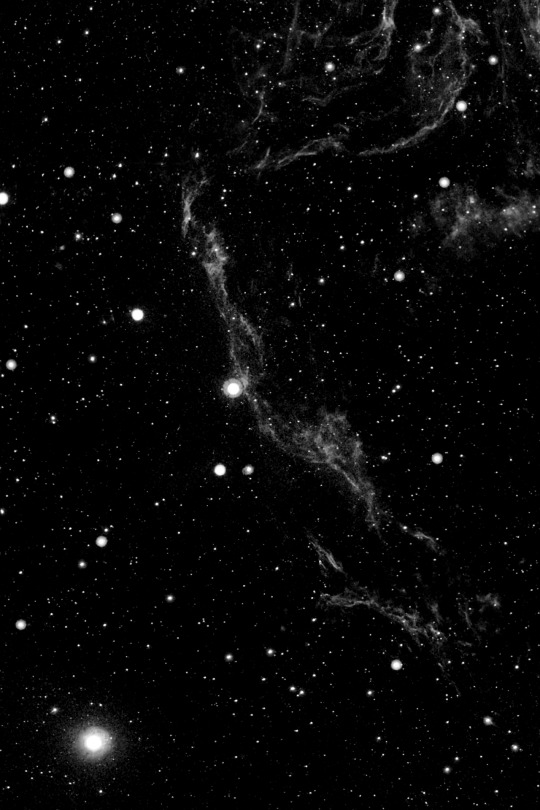
Tail of the Cygnus Loop Nebula
247 notes
·
View notes
Text
But You Know He Never Actually Said That, Right?

Cygnus Loop, as taken by the Hubble Telescope, released 1993.
Written for @loginceweek2023, Day 7: Importance
Rating: G - WC: 100
“Will any of this matter?”
Roman frowned down at his husband’s head where it lay on his chest. “Mi amor, what do you mean?”
“Look up,” he said, pointing to the stars that painted the night sky. “Some of those stars are already gone. No-one has noticed yet.”
Roman looked up. Then he smiled. “You’re right. Yet their light lives on.” He stroked Logan’s cheek. “They’re like you, mi amor,” Roman whispered. “Their importance outlived them by billions and billions of years.”
A smile grew on Logan’s face. “Excellent Cosmos reference, my Prince.”
“And billions,” Roman laughed.
“Billions,” Logan whispered.
#loginceweek2023#logince#ts logan#ts roman#importance#billions and billions and billions#carl sagan#Cygnus Loop#drabble#ts fanfic
19 notes
·
View notes
Text

14 hours of the Veil Nebula from my yard. Captured on my Canon 90D EOS DSLR at 135mm.
#my astrophotography#veil nebula#cygnus loop#nebula#nebulae#supernova remnant#supernova#space#astronomy
2 notes
·
View notes
Text

#gif#cartoon#anime#saint seiya#anime 80s#eris#evil goddess eris#cygnus hyoga#face#boucle#looping gif#smile
20 notes
·
View notes
Text
What is the Cygnus Loop Nebula?
Post #8 on Physics and Astronomy, 29/10/23
Some 1,500 light years away, a star doomed to its end explodes. Its remnants race into space at whirlwind speeds. Now referred to as the Cygnus Loop nebula, scientists have been able to capture some beautiful images from the Hubble telescope, as well as understand its nature better.

Discovered in 1784 by William Herschel, a star with mass over 20 times more than that of the Sun, exploded, ejecting its matter. The reason this is called the Cygnus nebula is because it was within the Cygnus constellation. What you see in the image above is the filaments of gas and dust visible as ultraviolet light. These were heated by the shockwave caused by the supernova, which, to this day, is still spreading outward from the original explosion.
Currently, the the shock is racing through space at a whopping 500,000 miles per hour (i.e. going to the moon and back in less than an hour). You may think that is a lot; however, relatively, this is quite slow, when you consider the average speed for a supernova shockwave (approximately 67,000,000 miles per hour).
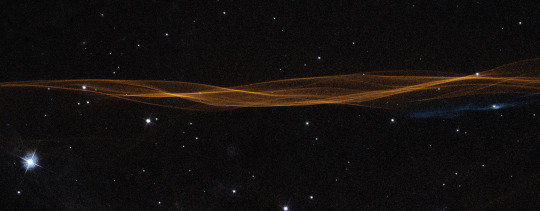
This photo shows a two-light-year-long section of glowing hydrogen filaments, which overall resembles a sheet if you viewed it from the side. They’re rippling, giving the appearance of twisted ribbons of light. This elegant shape arises as the shock waves encounters material of varying density.
The blue glow towards the back you see comes from the cooling of ionized oxygen atoms beginning to cool, emitting that glow.
Completely awe-inspiring, how today’s technology allows us to capture images like this in such crisp detail.
***
Sources:
Cygnus Loop image 1
Cygnus Loop image 2
#studyblr#physics#stem#sixth form#alevels#gcse#astronomy#astrophysics#engineering#the cygnus loop#nebula#pretty images#i can't stopstaring at the two photos#SO PRETTY#i love space#like omg
3 notes
·
View notes
Text
I hate the new ILNP bottles so much.
#I wish I bought another bottle of cygnus loop when they still had the old labels#This is my life these are my choices
0 notes
Text

Cygnus Loop - Color Splash! 500mp
#astronomy#nasa#astronomers#universe#astrophotography#nasa photos#nasawebb#astrophysics#astronomy photography#astro notes#astrography#astrology#goddard space flight center#galaxies#galaxy#our universe#spaceporn#space junk#space station#space photography#hubble space telescope#space science#space exploration#outer space#space#james webb space technology#james webb space telescope#nasa picture of the day#nebula#beautiful photos
290 notes
·
View notes
Photo

Cygnus Loop © George Chappel
#space#nasa#cygnus#astrophotography#stars#galaxy#night sky#planet#astronomy#planets#nebula#solar system#universe#cygnus loop#cosmos
569 notes
·
View notes
Photo
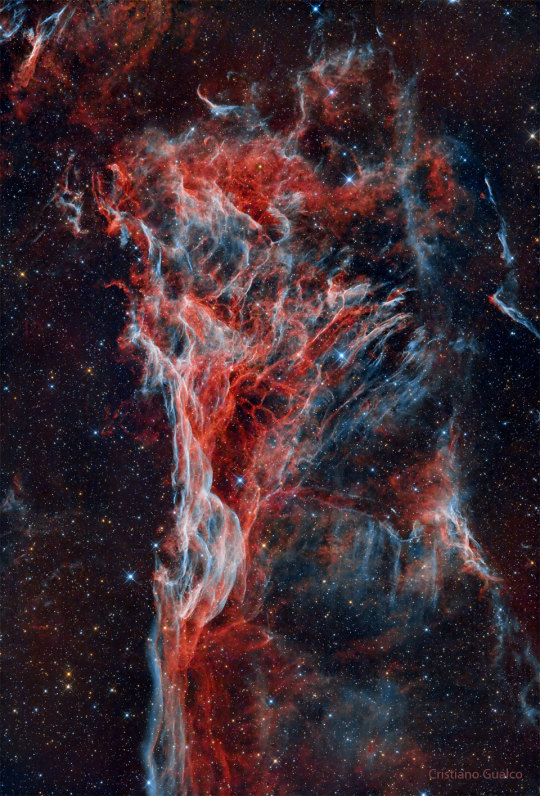
2023 November 21
Fleming's Triangular Wisp
Image Credit & Copyright: Cristiano Gualco
Explanation: These chaotic and tangled filaments of shocked, glowing gas are spread across planet Earth's sky toward the constellation of Cygnus as part of the Veil Nebula. The Veil Nebula itself is a large supernova remnant, an expanding cloud born of the death explosion of a massive star. Light from the original supernova explosion likely reached Earth over 5,000 years ago. The glowing filaments are really more like long ripples in a sheet seen almost edge on, remarkably well separated into the glow of ionized hydrogen atoms shown in red and oxygen in blue hues. Also known as the Cygnus Loop and cataloged as NGC 6979, the Veil Nebula now spans about 6 times the diameter of the full Moon. The length of the wisp corresponds to about 30 light years, given its estimated distance of 2,400 light years. Often identified as Pickering's Triangle for a director of Harvard College Observatory, it is perhaps better named for its discoverer, astronomer Williamina Fleming, as Fleming's Triangular Wisp.
∞ Source: apod.nasa.gov/apod/ap231121.html
170 notes
·
View notes
Text
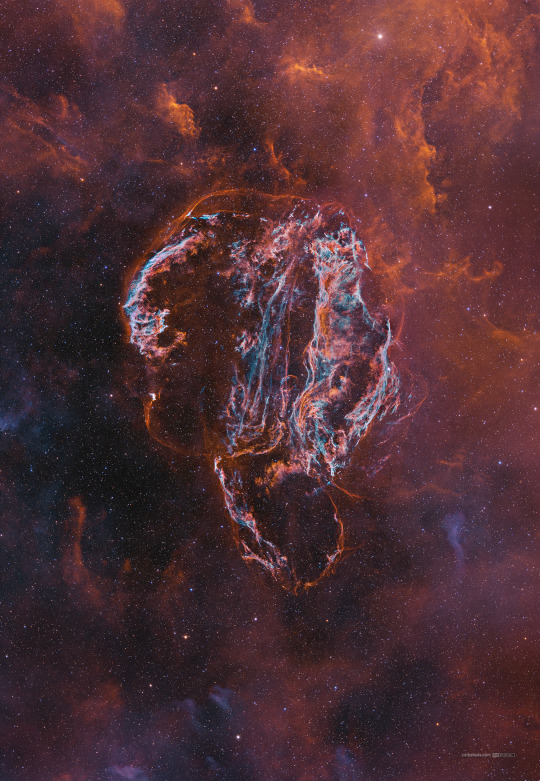
The Cygnus Loop, Sh2-103 // Jose Carballada
#astronomy#astrophotography#nebula#emission nebula#supernova remnant#cygnus loop#veil nebula#western veil nebula#eastern veil nebula#pickering's triangle#Sh2-103#NGC 6960#NGC 6992#NGC 6995#IC 1340#NGC 6974#NGC 6979#cygnus
101 notes
·
View notes
Text

Cygnus Loop Nebula
(Image credit: NASA/JPL-Caltech)
12 notes
·
View notes
Text

An area in the center of the Cygnus Loop supernova remnant called "Pickering's Triangle" 1,500 ly away.
131 notes
·
View notes